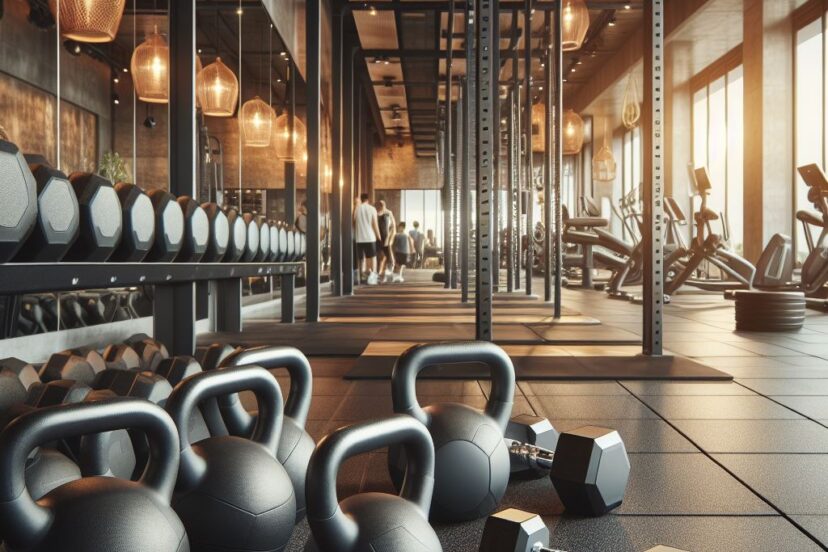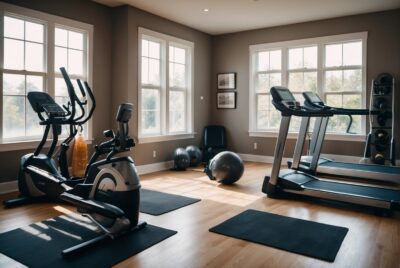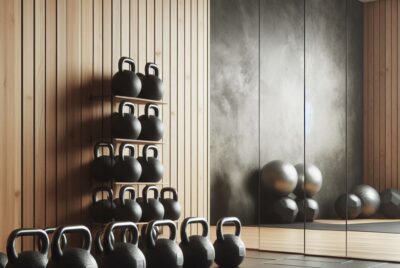Kettlebell vs Dumbbell: A Comprehensive Comparison
*We may earn a commission for purchases made using our links. Please see our disclosure to learn more.
Kettlebell vs Dumbbell: Weighing the Benefits for Your Workouts
The Ultimate showdown is here Kettlebell vs Dumbbell which is the best? So when evaluating fitness equipment, I often come across the debate of kettlebells versus dumbbells. Both are versatile tools that can enhance strength training, but they offer different benefits due to their unique designs. Dumbbells have a symmetrical weight distribution that is excellent for targeting specific muscle groups and can be easily integrated into a variety of workouts. They provide a stable form of resistance, which is conducive to exercises that demand strict form and isolation, like bicep curls or shoulder presses.

On the other hand, kettlebells feature an asymmetrical design with the weight centered below the handle, which adds a level of instability. This design promotes full-body movements and engages the core, mirroring real-world activities more closely than dumbbells. Kettlebell exercises such as swings, cleans, and snatches are dynamic and can improve both strength and cardiovascular fitness. As I explore these tools further, it becomes clear that each has its place depending on the user’s goals, preferences, and training style.
Kettlebell Vs Dumbbell: Understanding the Basics

In this section, I’ll address the fundamental differences between kettlebells and dumbbells that are critical for choosing the right equipment for your workout needs.
Design and Center of Gravity
The design differences between kettlebells and dumbbells influence their center of gravity. Kettlebells possess a unique shape with a handle above the weight, which creates a shifting center of gravity. This characteristic engages more stabilizer muscles during exercises. Dumbbells, on the other hand, have a fixed center of gravity with weight evenly distributed on each side of the handle, providing a stable and balanced lift.
Range of Motion and Versatility
When I consider range of motion and versatility, kettlebells excel due to their shape and handle design, allowing for dynamic movements that can combine strength and cardiovascular training. Dumbbells, while slightly less versatile, are superb for isolating muscle groups and can be used for a wide variety of exercises that require precise control.
- Kettlebells: Suited for swings, get-ups, and snatches.
- Dumbbells: Ideal for bicep curls, triceps extensions, and bench press variations.
Material and Durability
Kettlebells are typically made from cast iron or steel, materials that are highly durable and designed to withstand high-impact exercises. Dumbbells are available in a range of materials, including rubber-coated, hexagonal shapes to prevent rolling and provide durability. Both are enduring investments for home or commercial gyms.
- Kettlebells: Cast iron, steel, vinyl-coated.
- Dumbbells: Rubber-coated, urethane, metal.
Kettlebell vs Dumbbell Techniques and Exercises Compared

When I discuss the techniques and exercises of kettlebells and dumbbells, I focus on specific movements that best illustrate the capabilities and benefits of each piece of equipment.
Kettlebell Swings and Dynamic Movements
Kettlebell swings exemplify dynamic movements that leverage the kettlebell’s unique design. The off-centered weight distribution of a kettlebell challenges stabilizer muscles during the swing, enhancing functional strength and conditioning. A kettlebell swing engages the hips, glutes, and lower back, promoting a full range of motion and explosive power that’s pivotal for dynamic movements.
- Technique: I ensure the kettlebell swing starts with a hinge at the hips, not a squat. The motion is a powerful hip thrust, using the legs and glutes to propel the kettlebell forward and upward.
- Muscles Worked: Primarily hamstrings, glutes, lower back, shoulders, and core.
Dumbbell Presses and Isolation Exercises
For dumbbell presses and isolation exercises, dumbbells come into play effectively due to their symmetrical design. A traditional dumbbell press involves less complexity in grip and positioning, making it ideal for targeting specific muscle groups with precision—focusing on the chest, shoulders, and arms. This type of lift benefits from a controlled range of motion, which is essential for isolation exercises.
- Technique: My dumbbell press technique includes sitting or lying on a bench, pressing the dumbbells from shoulder height to fully extended above me, and back down with control.
- Muscles Worked: Typically pectoralis major, deltoids, triceps.
By examining these exercises, one can appreciate the functional differences between kettlebells and dumbbells in terms of their optimal use cases.
Training Outcomes: Strength, Power, and Muscle Building

I find it essential to understand the impact of equipment choice on training outcomes. The specific attributes that both kettlebells and dumbbells contribute to training are distinct, especially when it comes to enhancing strength, power, and muscle building. Let me explain how each tool fits into the puzzle of physical development.
Strength Training and Power Development
Strength training: My experience aligns with the general consensus that dumbbells are extremely effective for strength training. By allowing for independent movement of each arm, they facilitate a greater emphasis on stabilizing muscles which contribute to increased overall strength.
Power development: I take note that kettlebells are often the preferred choice for power development exercises. This is attributed to their design, which is conducive to dynamic movements like swings, snatches, and cleans. Such movements engage the body in producing explosive power.
- Key Exercises:
- Dumbbells: Bench press, shoulder press, bicep curls.
- Kettlebells: Kettlebell swings, snatches, Turkish get-ups.
Muscle Growth and Body Conditioning
Muscle growth: When I focus on hypertrophy, I often turn to dumbbells. Their ability to isolate specific muscles makes them ideal for targeted muscle-building.
Conditioning: On the other hand, I find kettlebells to be particularly beneficial for high-intensity workouts that improve conditioning and overall functional fitness. The fluidity of kettlebell movements can engage multiple muscle groups simultaneously, thereby offering a compound exercise effect that can elevate heart rate and enhance muscle endurance.
- Key Exercises:
- Dumbbells: Concentration curls, tricep kickbacks, dumbbell flyes.
- Kettlebells: Kettlebell jerks, windmills, high pulls.
In my application of these tools, I am always cognizant of the fact that both dumbbells and kettlebells can efficiently contribute to a well-rounded fitness regimen, each with a specific set of strengths for augmenting one’s fitness goals in strength, power, and muscle-building exercises.
Convenience and Accessibility in Home and Commercial Gyms

In my experience with fitness equipment, convenience and accessibility are crucial for both home and commercial gym settings. I’ll discuss the spatial and functional aspects of kettlebells and dumbbells, considering the demands of diverse workout environments.
Space Efficiency and Weight Range for Kettlebell vs Dumbbell
Kettlebells:
- Adjustable kettlebell: Typically ranges from 8-32 kg, offering a space-saving solution for home gyms.
- Footprint: Smaller, as a single adjustable kettlebell can replace multiple fixed weights.
Dumbbells:
- Adjustable dumbbells: Allow for precise weight selection, targeting a broad spectrum of exercises and fitness levels.
- Storage: Rack systems for fixed weights can be bulky, whereas adjustable sets conserve space significantly.
Kettlebell vs Dumbbell Ease of Use and Exercise Selection
Kettlebells:
- Grip: The handle design facilitates dynamic movements like swings and snatches.
- Exercises: Ideal for ballistic workouts, enhancing power and functional strength.
Dumbbells:
- Familiarity: Commonly found in gyms, making them a go-to for many exercisers.
- Variety: Suitable for a wide range of exercises, from bicep curls to bench presses, favoring both isolation and compound movements.
Both kettlebells and dumbbells serve distinct purposes in a workout regimen. For a home gym owner who prioritizes space, adjustable kettlebells might be more convenient, whereas in a commercial gym, the broad weight range and familiarity of dumbbells may offer greater accessibility to patrons. My selection between the two would depend on the specific workout goals and the environment in question.
Safety and Effectiveness of Kettlebell vs Dumbbell Workouts

In evaluating the safety and effectiveness of kettlebell and dumbbell workouts, two key factors to consider are the proper execution of exercises and the distinct advantages of stabilizing versus mobilizing loads.
Kettlebell vs Dumbbell Proper Form and Risk of Injury
Regarding safety, I understand that maintaining proper form is crucial to minimize the risk of injury when using kettlebells or dumbbells. Incorrect techniques, particularly with heavier weights, can lead to strain on my wrist or elbow joints. Kettlebells, with their off-center mass, require a robust grip and precise control, which can challenge my form and poses a different kind of risk compared to dumbbells. Conversely, dumbbells, with their symmetrical weight distribution, are less likely to cause injury due to improper weight balance, but they still demand attention to form to prevent overextension or strain.
- Kettlebells: Risk originates from a lack of control over the bell’s path, emphasizing the need for a strong grip and awareness of its swing arc.
- Dumbbells: Risk may arise from misalignment during lifts or carrying heavy weight without adequate muscle engagement, emphasizing elbow and wrist stability.
Kettlebell vs Dumbbell: Benefits of Stable and Unstable Loads
On the matter of effectiveness, stable loads provided by dumbbells are excellent for targeting specific muscle groups with traditional exercises like curls and presses. Stability, in this context, tends to allow me to hone in on particular muscles, making dumbbells an ideal choice for isolation workouts.
- Dumbbells: The equal-weight ends offer a stable weight that can enhance my focus on strength in isolated muscle regions.
Kettlebells introduce instability that engages my core and accessory muscles, effectively enhancing functional strength and dynamic movement patterns. Their unique shape and weight distribution promote a different aspect of effectiveness through movements that mimic real-world activities, improving my overall athletic performance.
- Kettlebells: The uneven weight distribution forces my body to compensate, activating multiple muscle groups for a comprehensive training effect, elevating my grip strength, and contributing to dynamic functional fitness.
Incorporating both kettlebells and dumbbells into my workout routine can provide a balanced approach, leveraging the stability of dumbbells for focused strength training and the instability of kettlebells for functional conditioning.
Optimizing Performance: Tailoring Your Routine
When constructing a workout regimen, it’s essential to align the choice of equipment with my training and fitness goals. Selecting the appropriate free weights, such as kettlebells or dumbbells, will directly impact my performance outcomes.
Choosing Between a Kettlebell and Dumbbell
I consider the specific qualities of each type of weight when tailoring my routine. Kettlebells, recognized for their unique shape with a handle and uneven weight distribution, demand greater muscular control which benefits functional training and explosive movements. This makes them a prime option for dynamic exercises like swings, snatches, and high pulls that aim to enhance my overall power.
- Functional Training:
- Kettlebells: Excellent for compound movements, improving grip strength and coordination.
- Dumbbells: Ideal for more controlled, stable movements.
- Explosive Power:
- Kettlebells: Designed for ballistic exercises, supporting full-body workouts.
- Dumbbells: Less suited for ballistic movements but can still aid in plyometric training when used properly.
Dumbbells, on the other hand, provide even weight distribution and are particularly well-suited for isolation exercises. They come in handy when I focus on targeting specific muscle groups, as in bicep curls or tricep extensions, and allow for a straight forward progress in resistance training.
- Isolation Exercises:
- Dumbbells: Allow precise muscle targeting, essential for bodybuilding and muscle hypertrophy.
- Kettlebells: Can be used for isolation but require more care due to their shape.
Integrating Free Weights into Your Fitness Goals
A balanced fitness routine involves a considered approach towards including free weights that complement my goals. I prioritize kettlebells when my objective is to build functional strength and endurance since they activate multiple muscle groups simultaneously. For instance, kettlebell goblet squats are effective in engaging not only my quads but also my core and upper body.
- Functional Strength and Endurance:
- Kettlebells: Engage various muscle groups; promote stability and mobility.
- Dumbbells: Also engage multiple muscle groups with the added benefit of unilateral training to cater to individual limb strength.
In contrast, when my focus is on hypertrophy or muscle balance, dumbbells become my go-to, as they facilitate unilateral training which helps in correcting strength imbalances. Its simplicity in adding increments of weight makes it conducive to linear progression in a strength-training program.
- Hypertrophy and Muscle Balance:
- Dumbbells: Offer ease in progressive overload, essential for muscle growth.
- Kettlebells: Less conventional for this goal but possible with proper technique.
By understanding the demands of my training and aligning them with the functionality of each type of weight, I am able to optimize my workout routine. Whether I am using kettlebells or dumbbells, the key lies in choosing the tool that best suits the exercises I am performing and the fitness outcomes I desire.
Frequently Asked Questions for Kettlebell vs Dumbbell
In this section, I’ll address some common queries regarding the use of kettlebells and dumbbells, focusing on their specific benefits for home gyms, weight loss effectiveness, muscle targeting, suitability for bodybuilding, and performance during squats, and muscle-building capabilities.
1. What are the benefits of using kettlebells compared to dumbbells for a home gym?
Kettlebells are versatile and great for dynamic movements and exercises that benefit from an uneven weight distribution, like swings or snatches. This can add functional strength and conditioning elements to a home gym routine.
2. In terms of weight loss, are kettlebells or dumbbells more effective?
Kettlebells often involve more full-body movements which can increase heart rate and calorie burn, potentially offering a slight edge in weight loss scenarios. Dumbbells, however, can still be incorporated into high-intensity training regimes that are also effective for weight loss.
3. How do kettlebells and dumbbells compare when targeting glute muscles?
Dumbbells allow for a wide range of isolated glute exercises like lunges and deadlifts. Kettlebells can also be used for such exercises, in addition to movements like swings, which actively engage the glutes in a dynamic fashion.
4. Which is more suitable for bodybuilding: kettlebells or dumbbells?
Dumbbells are more traditional in bodybuilding for isolated muscle training and hypertrophy. They offer precise control over load progression, essential for muscle building.
5.Can you achieve the same muscle-building results with kettlebells as with dumbbells?
Both kettlebells and dumbbells can be effective for muscle-building. The key is to incorporate progressive overload and consistency. Dumbbells allow for more precise weight increments, which might be more conducive to traditional muscle-building protocols.




